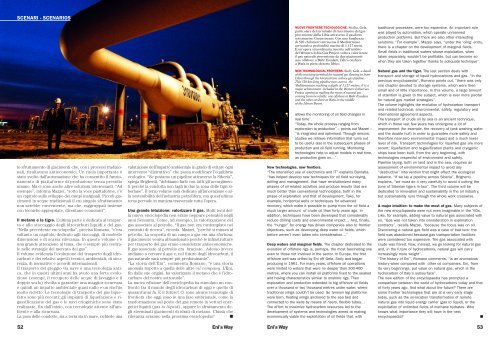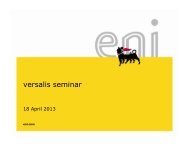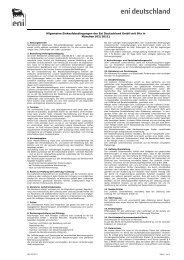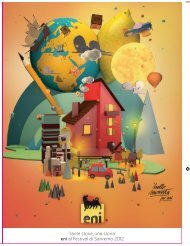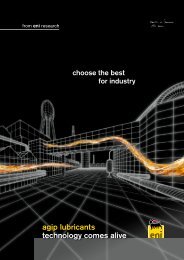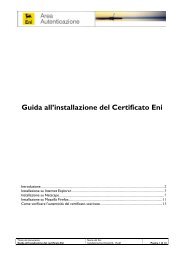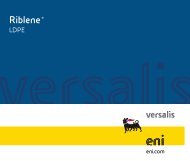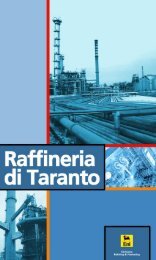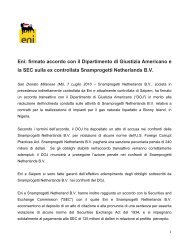È in corso il restauro conservativo del Duomo di Milano. Un ... - Eni
È in corso il restauro conservativo del Duomo di Milano. Un ... - Eni
È in corso il restauro conservativo del Duomo di Milano. Un ... - Eni
You also want an ePaper? Increase the reach of your titles
YUMPU automatically turns print PDFs into web optimized ePapers that Google loves.
SCENARI - SCENARIOS<br />
lo sfruttamento <strong>di</strong> giacimenti che, con i processi tra<strong>di</strong>zionali,<br />
risultavano antieconomici. <strong>Un</strong> ruolo importante è<br />
stato svolto dall’automazione che ha consentito <strong>il</strong> funzionamento<br />
<strong>di</strong> piattaforme <strong>di</strong> produzione senza presi<strong>di</strong>o<br />
umano. Ma ci sono anche altre soluzioni <strong>in</strong>teressanti. “Ad<br />
esempio”, <strong>in</strong>forma Mazzei, “sotto la voce piattaforme, c’è<br />
un capitolo sullo sv<strong>il</strong>uppo dei campi marg<strong>in</strong>ali. Piccoli giacimenti<br />
<strong>in</strong> acque tra<strong>di</strong>zionali <strong>il</strong> cui s<strong>in</strong>golo sfruttamento<br />
non sarebbe conveniente, ma che, raggruppati <strong>in</strong>sieme<br />
con tecniche appropriate, <strong>di</strong>ventano economici”.<br />
Il metano e la tigre. L’ultima parte è de<strong>di</strong>cata al trasporto<br />
e allo stoccaggio degli idrocarburi liqui<strong>di</strong> e <strong>del</strong> gas.<br />
“Nella precedente enciclope<strong>di</strong>a”, precisa Romano, “c’era<br />
soltanto un capitolo, de<strong>di</strong>cato agli stoccaggi, <strong>di</strong> modeste<br />
<strong>di</strong>mensioni e <strong>di</strong> scarsa r<strong>il</strong>evanza. In questo volume c’è<br />
una grande attenzione al tema, che è sempre più centrale<br />
nelle strategie <strong>del</strong> mercato <strong>del</strong> gas”.<br />
Il volume evidenzia l’evoluzione <strong>del</strong> trasporto degli idrocarburi<br />
e dei relativi aspetti tecnici, ambientali, <strong>di</strong> sicurezza,<br />
<strong>di</strong> normative e accor<strong>di</strong> <strong>in</strong>ternazionali.<br />
Il trasporto <strong>del</strong> greggio via nave è una tecnologia antica,<br />
che <strong>in</strong> questi ultimi anni ha avuto una forte evoluzione<br />
(esempi, <strong>il</strong> recupero <strong>del</strong>le acque <strong>di</strong> lavaggio e <strong>il</strong><br />
doppio scafo) rivolta a garantire una maggior sicurezza<br />
e qu<strong>in</strong><strong>di</strong> un impatto ambientale quasi nullo e un rischio<br />
molto ridotto. Le tecnologie <strong>di</strong> trasporto <strong>del</strong> gas liquefatto<br />
sono più recenti: gli impianti <strong>di</strong> liquefazione e rigassificazione<br />
<strong>del</strong> gas e le navi criogeniche sono state<br />
realizzate, f<strong>in</strong> dall’<strong>in</strong>izio, con tecnologie attente all’ambiente<br />
e alla sicurezza.<br />
La posa <strong>del</strong>le condotte, sia a terra sia <strong>in</strong> mare, richiede una<br />
52<br />
valutazione <strong>del</strong>l’impatto ambientale <strong>in</strong> grado <strong>di</strong> evitare ogni<br />
<strong>in</strong>tervento “<strong>di</strong>struttivo” che possa mo<strong>di</strong>ficare l’equ<strong>il</strong>ibrio<br />
ecologico. “Se posiamo un pipel<strong>in</strong>e attraverso la Siberia”,<br />
spiega Brighenti, “dobbiamo farlo con tutti gli accorgimenti<br />
perché la condotta non tagli <strong>in</strong> due la zona <strong>del</strong>le tigri siberiane”.<br />
Il terzo volume sarà de<strong>di</strong>cato all’<strong>in</strong>novazione e alla<br />
sostenib<strong>il</strong>ità <strong>del</strong>l’<strong>in</strong>dustria petrolifera, ma quest’ultimo<br />
tema pervade <strong>in</strong> maniera trasversale tutta l’opera.<br />
<strong>Un</strong>a grande <strong>in</strong>tuizione: valorizzare <strong>il</strong> gas. Molti temi <strong>del</strong>la<br />
nuova enciclope<strong>di</strong>a non erano neppure pensab<strong>il</strong>i negli<br />
anni Sessanta. Come, ad esempio, la valorizzazione <strong>del</strong><br />
gas associato al petrolio. “Il gas non era contemplato nei<br />
contratti <strong>di</strong> ricerca”, ricorda Mazzei, “perché si mirava al<br />
petrolio. La scoperta <strong>di</strong> un campo a gas era una sfortuna:<br />
<strong>il</strong> giacimento veniva abbandonato perché le <strong>in</strong>frastrutture<br />
per trasporto <strong>del</strong> gas erano considerate antieconomiche.<br />
Il gas associato al petrolio era bruciato. Adesso <strong>in</strong>vece<br />
an<strong>di</strong>amo a cercare <strong>il</strong> gas e, nel futuro degli idrocarburi, <strong>il</strong><br />
gas naturale sarà sempre più predom<strong>in</strong>ante”.<br />
“La storia <strong>del</strong>l’<strong>Eni</strong>”, commenta Romano, “è una storia<br />
anomala rispetto a quella <strong>del</strong>le altre o<strong>il</strong> company. L’<strong>Eni</strong>,<br />
f<strong>in</strong> dalle sue orig<strong>in</strong>i, ha valorizzato <strong>il</strong> metano che è l’idrocarburo<br />
<strong>del</strong> nostro sottosuolo”.<br />
La nuova e<strong>di</strong>zione <strong>del</strong>l’enciclope<strong>di</strong>a ha stimolato un confronto<br />
tra <strong>il</strong> mondo degli idrocarburi <strong>di</strong> oggi e quello <strong>di</strong><br />
quarant’anni fa. E <strong>il</strong> futuro? Ci sono alcune tecnologie <strong>di</strong><br />
frontiera che oggi sono <strong>in</strong> una fase embrionale, come la<br />
trasformazione sul posto <strong>del</strong> gas remoto <strong>in</strong> vettori energetici<br />
liqui<strong>di</strong> (gas to liquid), oppure lo sfruttamento degli<br />
sterm<strong>in</strong>ati giacimenti <strong>di</strong> idrati <strong>di</strong> metano. Chissà che<br />
r<strong>il</strong>evanza avranno nella prossima enciclope<strong>di</strong>a? ■<br />
<strong>Eni</strong>’s Way<br />
allows the monitor<strong>in</strong>g of o<strong>il</strong> field changes <strong>in</strong><br />
real time”.<br />
“Today, the whole process rang<strong>in</strong>g from<br />
exploration to production” – po<strong>in</strong>ts out Mazzei –<br />
“is <strong>in</strong>tegrated and optimised. Through seismic<br />
stu<strong>di</strong>es we retrieve <strong>in</strong>formation that turns out<br />
to be useful also <strong>in</strong> the subsequent phases of<br />
production and o<strong>il</strong> field runn<strong>in</strong>g. Monitor<strong>in</strong>g<br />
technologies help to adjust mo<strong>del</strong>s <strong>in</strong> real time,<br />
as production goes on…”.<br />
New technologies, new frontiers.<br />
“The <strong>in</strong>tensified use of electronics and IT” expla<strong>in</strong>s Barnaba,<br />
“has helped develop new techniques for o<strong>il</strong> field survey<strong>in</strong>g,<br />
dr<strong>il</strong>l<strong>in</strong>g and management, that have revolutionized many<br />
phases of o<strong>il</strong>-related activities and produce results that are<br />
much better than conventional technologies, both <strong>in</strong> the<br />
phase of exploration and that of development. Take, for<br />
example, horizontal wells or techniques for advanced<br />
recovery, which make it possible to pump from the o<strong>il</strong> field a<br />
much larger amount of crude o<strong>il</strong> than forty years ago. In<br />
ad<strong>di</strong>tion, techniques have been developed that considerably<br />
reduce dr<strong>il</strong>l<strong>in</strong>g costs and environmental impact… And, f<strong>in</strong>ally,<br />
the “hunger” for energy has driven companies also to frontier<br />
objectives, such as develop<strong>in</strong>g deep water o<strong>il</strong> fields, which<br />
before weren’t even taken <strong>in</strong>to consideration…”<br />
Deep waters and marg<strong>in</strong>al fields. The chapter de<strong>di</strong>cated to the<br />
evolution of offshore rigs is, perhaps, the most fasc<strong>in</strong>at<strong>in</strong>g one<br />
even to those not <strong>in</strong>volved <strong>in</strong> the sector. In Europe, the first<br />
offshore well was dr<strong>il</strong>led by <strong>Eni</strong> off Gela, Sic<strong>il</strong>y and began<br />
produc<strong>in</strong>g <strong>in</strong> 1961. For many years, offshore o<strong>il</strong> operations<br />
were limited to waters that were no deeper than 300-400<br />
metres, where you can <strong>in</strong>stall o<strong>il</strong> platforms fixed to the seabed<br />
and hav<strong>in</strong>g characteristics sim<strong>il</strong>ar to onshore rigs. Then<br />
exploration and production extended to big offshore o<strong>il</strong> fields<br />
over a thousand or two thousand metres under water, where<br />
tra<strong>di</strong>tional o<strong>il</strong>rigs couldn’t be used. So tension leg platforms<br />
were born, float<strong>in</strong>g o<strong>il</strong>rigs anchored to the sea bed and<br />
connected to the wells by means of risers, flexible tubes…<br />
The effort to maximize hydrocarbon resources led to the<br />
development of systems and technologies aimed at mak<strong>in</strong>g<br />
economically viable the exploitation of o<strong>il</strong> fields that, with<br />
<strong>Eni</strong>’s Way<br />
NUOVE FRONTIERE TECNOLOGICHE. Sic<strong>il</strong>ia, Gela,<br />
particolare <strong>del</strong> term<strong>in</strong>ale <strong>di</strong> ricevimento <strong>del</strong> gas<br />
proveniente dalla Libia attraverso <strong>il</strong> gasdotto<br />
sottomar<strong>in</strong>o Greenstream. Con una lunghezza<br />
<strong>di</strong> 520 ch<strong>il</strong>ometri attraversa <strong>il</strong> Me<strong>di</strong>terraneo<br />
arrivando a profon<strong>di</strong>tà mar<strong>in</strong>e <strong>di</strong> 1.127 metri.<br />
<strong>È</strong> un’opera straord<strong>in</strong>aria <strong>in</strong>serita nell’ambito<br />
<strong>del</strong> Western Lybia Gas Project volto a valorizzare<br />
<strong>il</strong> gas naturale proveniente da due giacimenti:<br />
uno offshore a Bahr Essalam, l’altro onshore<br />
a Wafa <strong>in</strong> pieno deserto libico.<br />
NEW TECHNOLOGICAL FRONTIERS. Sic<strong>il</strong>y, Gela, a deta<strong>il</strong><br />
of the receiv<strong>in</strong>g term<strong>in</strong>al for natural gas flow<strong>in</strong>g <strong>in</strong> from<br />
Libya through the Greenstream subsea gas pipel<strong>in</strong>e.<br />
This 520-km-long pipel<strong>in</strong>e runs across the<br />
Me<strong>di</strong>terranean reach<strong>in</strong>g a depth of 1,127 meters. It is a<br />
major achievement <strong>in</strong>cluded <strong>in</strong> the Western Lybia Gas<br />
Project aim<strong>in</strong>g at mak<strong>in</strong>g the most of natural gas<br />
com<strong>in</strong>g from two fields: one offshore at Bahr Essalam<br />
and the other onshore at Wafa <strong>in</strong> the middle<br />
of the Libyan Desert.<br />
tra<strong>di</strong>tional processes, were too expensive. An important role<br />
was played by automation, which operate unmanned<br />
production platforms. But there are also other <strong>in</strong>terest<strong>in</strong>g<br />
solutions. “For example”, Mazzei says, “under the ‘o<strong>il</strong>rig’ entry,<br />
there is a chapter on the development of marg<strong>in</strong>al fields.<br />
Small fields <strong>in</strong> tra<strong>di</strong>tional waters whose exploitation, when<br />
taken separately, wouldn’t be profitable, but can become so<br />
when they are taken together thanks to adequate technique”.<br />
Natural gas and the tiger. The last section deals with<br />
transport and storage of liquid hydrocarbons and gas. “In the<br />
previous encyclopae<strong>di</strong>a”, Romano po<strong>in</strong>ts out, “there was only<br />
one chapter devoted to storage systems, which were then<br />
small and of little importance. In this volume, a large amount<br />
of attention is given to the subject, which is ever more pivotal<br />
for natural gas market strategies”.<br />
The volume highlights the evolution of hydrocarbon transport<br />
and related technical, environmental, safety, regulatory and<br />
<strong>in</strong>ternational agreement aspects.<br />
The transport of crude o<strong>il</strong> by sea is an ancient technique,<br />
which <strong>in</strong> these last few years has undergone a lot of<br />
improvement (for example, the recovery of tank wash<strong>in</strong>g water<br />
and the double hull) <strong>in</strong> order to guarantee more safety and<br />
therefore near-zero environmental impact and a much lower<br />
level of risk. Transport technologies for liquefied gas are more<br />
recent: liquefaction and re-gasification plants and cryogenic<br />
ships have been bu<strong>il</strong>t, from the very beg<strong>in</strong>n<strong>in</strong>g, with<br />
technologies respectful of environment and safety.<br />
Pipel<strong>in</strong>e lay<strong>in</strong>g, both on land and <strong>in</strong> the sea, requires an<br />
assessment of environmental impact to avoid any<br />
“destructive” <strong>in</strong>tervention that might affect the ecological<br />
balance. “If we lay a pipel<strong>in</strong>e across Siberia”, Brighenti<br />
expla<strong>in</strong>s, “we must do it very carefully to avoid it cutt<strong>in</strong>g the<br />
zone of Siberian tigers <strong>in</strong> two”. The third volume w<strong>il</strong>l be<br />
de<strong>di</strong>cated to <strong>in</strong>novation and susta<strong>in</strong>ab<strong>il</strong>ity <strong>in</strong> the o<strong>il</strong> <strong>in</strong>dustry,<br />
but susta<strong>in</strong>ab<strong>il</strong>ity runs through the whole work crosswise.<br />
A major <strong>in</strong>tuition: to make the most of gas. Many subjects of<br />
the new encyclopae<strong>di</strong>a were not even imag<strong>in</strong>able <strong>in</strong> the ’60s.<br />
Like, for example, add<strong>in</strong>g value to natural gas associated with<br />
o<strong>il</strong>. “Gas was not taken <strong>in</strong>to consideration <strong>in</strong> exploration<br />
contracts”, recalls Mazzei, “because the focus was on o<strong>il</strong>.<br />
Discover<strong>in</strong>g a natural gas field was a case of bad luck: the<br />
field was abandoned because gas transportation fac<strong>il</strong>ities<br />
were considered too expensive. The gas associated with<br />
crude was flared. Now, <strong>in</strong>stead, we go look<strong>in</strong>g for natural gas<br />
and, <strong>in</strong> the future of hydrocarbons, natural gas w<strong>il</strong>l carry<br />
<strong>in</strong>creas<strong>in</strong>gly more weight”.<br />
“The history of <strong>Eni</strong>”, Romano comments, “is an anomalous<br />
history when compared with other o<strong>il</strong> companies. <strong>Eni</strong>, from<br />
its very beg<strong>in</strong>n<strong>in</strong>gs, put value on natural gas, which is the<br />
hydrocarbon of Italy’s subsurface”.<br />
The new e<strong>di</strong>tion of the encyclopae<strong>di</strong>a has prompted a<br />
comparison between the world of hydrocarbons today and that<br />
of forty years ago. And what about the future? There are<br />
some frontier technologies that are at a very early stage<br />
today, such as the on-location transformation of remote<br />
natural gas <strong>in</strong>to liquid energy carrier (gas to liquid), or the<br />
exploitation of unlimited fields of methane hydrates. Who<br />
knows what importance they w<strong>il</strong>l have <strong>in</strong> the next<br />
encyclopae<strong>di</strong>a? ■<br />
53


